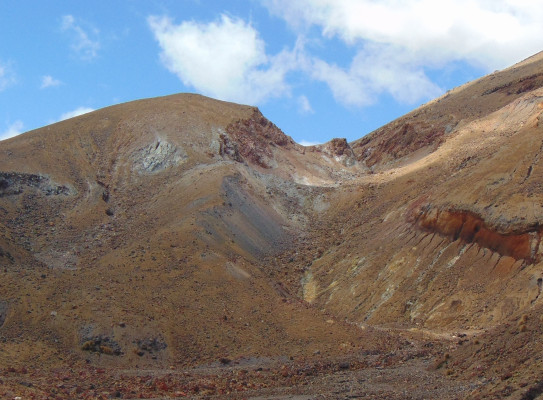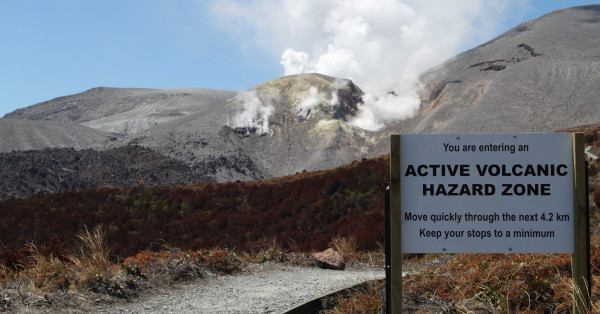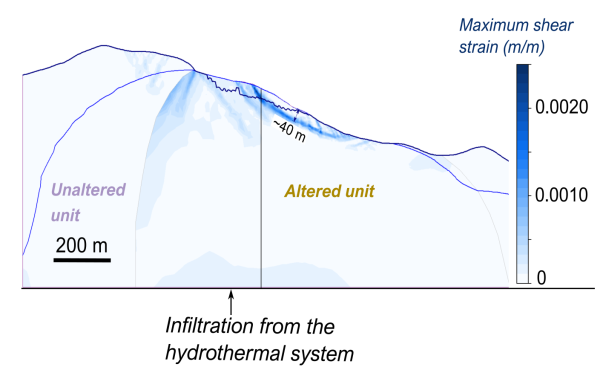When volcanoes fall apart: What failure mechanics can teach us

When we think of volcanoes, we often picture fiery eruptions and plumes of ash. But sometimes, the danger lies not in what a volcano throws out, but in what it lets go of. Entire sections of volcanic slopes can collapse, unleashing fast-moving landslides of rock and debris that race down the mountain. These events – called debris avalanches – can happen with little warning and have devastating consequences for anyone living nearby.
So how and why do volcanoes collapse? A recent study by Vicente et al. (2025)(external link) explores how and why volcanic slopes collapse, using the field of failure mechanics to understand the physical processes that lead to these events.
What is failure mechanics?
Failure mechanics is the study of how and why structures – like the steep slopes of a volcano – break down. In the case of volcanoes, it helps scientists understand the physical processes that cause a slope to become unstable and fail.
This matters because once a slope gives way, it can quickly turn into a debris avalanche. These landslides are powerful, fast, and unpredictable. By understanding what weakens volcanic slopes and what finally causes them to collapse, scientists can better predict where, when, and how far these destructive flows might travel.
A real-life case: The 2012 Te Maari collapse
One of New Zealand’s best-documented volcanic landslides happened in 2012 at Te Maari, part of the Tongariro volcano. Luckily, no one was hurt – but the event left behind a clear trail of destruction. What makes this collapse especially useful to scientists is the wealth of data we have from before and after the event. That includes detailed maps of the landscape, underground images, and on-the-ground observations. This makes Te Maari a perfect case study to explore how volcanic slopes fail – especially when there's an active hydrothermal system involved.

So, what’s a hydrothermal system?
Hydrothermal systems are networks of hot, acidic fluids (like steam and boiling water) that move through cracks inside the volcano. Over time, these fluids can change the rocks they pass through – turning strong, solid materials into softer, weaker ones. Imagine slowly soaking a brick in acid; eventually, it starts to crumble. The same thing happens inside a volcano.
These chemical changes weaken the rock, and the pressure from the fluids can push on the rock from the inside. That combination makes the slope more likely to collapse – especially if something else, like a small earthquake, gives it a little extra nudge.
To understand the Te Maari collapse better, Vicente et al (2025) ran a series of computer simulations – basically virtual experiments using real-world data. The authors tested different scenarios: How much water pressure would it take to cause a collapse? What if the rock was already weak? What role did small earthquakes play?
Using satellite images, seismic recordings, geological surveys, and field observations to guide our models, the authors created a realistic picture of what might have happened beneath the surface in the lead-up to the 2012 event.
What the authors found was surprising that a small increase in water pressure near the surface, likely caused by deeper fluid movement, was enough to trigger the collapse. And it didn’t happen all at once. Their model showed two separate blocks of the volcano breaking off in sequence – just like what was seen in the field after the event.
These findings provide a clearer understanding of how volcanic landslides like Te Maari happen – and more importantly, how to recognise the warning signs in other places, like Whakaari/White Island, which also has an active hydrothermal system.

Why this matters
Understanding failure mechanics isn’t just about explaining the past – it’s about protecting the future. By learning how volcanoes collapse and what triggers these dangerous events, we can better assess the risks they pose and potentially give more accurate warnings.
Te Maari gave us a rare and valuable look into the hidden processes that can lead to disaster. Now, with the help of science and simulations, we’re turning that knowledge into tools that could one day save lives. Our volcanoes are powerful, but with the right knowledge, we can live with them more safely.
Hero image: Down view of the channel and the scar from the 2012 Te Maari debris avalanche (Feb 2023)